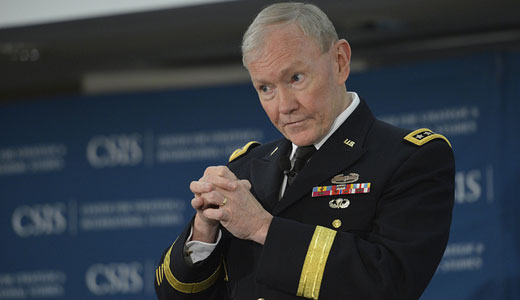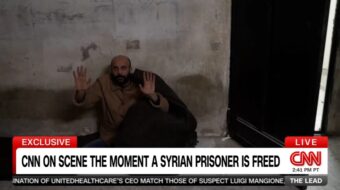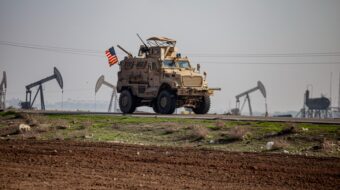
The nation’s top military official, Gen. Martin Dempsey, has told Congress that U.S. options for military intervention in Syria would cost “billions” and require massive commitments of troops as well as planes, ships, submarines, and other equipment. These would also be risky ventures, he said.
At the same time, it appears that CIA shipments of small arms to Syrian rebels will begin shortly. House and Senate committees have approved the plan. Also reportedly under discussion is supplying the rebels with heat-seeking missiles, which can shoot down aircraft.
This has drawn the disapproval of Lakhdar Brahimi, the United Nations special envoy to Syria. “Arms do not make peace,” he told the New York Times. “We would like to see the delivery of arms stopped to all sides.”
Dempsey, head of the Pentagon’s Joint Chiefs of Staff, outlined several military options in a July 19 letter to the chair of the Senate Armed Services Committee, Carl Levin, D-Mich. The letter was made public this week. Dempsey testified before the committee last week.
Long-range strikes on Syrian government military targets would require “hundreds of aircraft, ships, submarines and other enablers,” and cost “in the billions,” Dempsey said in the letter.
Training, advising and assisting the opposition, Dempsey wrote, could require anywhere from several hundred to several thousand troops, and cost about $500 million a year “initially.” Risks include “extremists gaining access to additional capabilities,” or “inadvertent association with war crimes” due to the difficulty in knowing who is who among the rebel forces.
Imposing a no-fly zone would require shooting down Syrian government warplanes and destroying airfields and related infrastructure, Dempsey said. It would require hundreds of aircraft and support personnel. The cost could reach $1 billion a month, and it might not impact the war’s outcome, he said.
Establishment of “buffer zones” in neighboring countries to provide safe havens for Syrian rebels and a base for delivering humanitarian assistance, he said, would, in addition to requiring a no-fly zone, also require “thousands” of U.S. ground troops.
A mission to prevent the use or proliferation of chemical weapons, the general said, would require a no-fly zone and a major campaign of air and missile strikes. “Thousands of special operations forces and other ground forces would be needed to assault and secure critical sites,” he wrote, with costs “well over $1 billion a month.”
President Obama until recently resisted military intervention in Syria despite pressure from Republicans and some Democrats. However in June he announced that the U.S. would begin sending direct military aid to Syrian rebels seeking to oust Syria’s President Bashar al-Assad. The rationale cited was the assertion that the Syrian government had used chemical weapons, a violation of international law. However that assertion has been challenged by many. The administration gave few specifics at that time about exactly what military aid would be provided and when, but officials indicated that the plan was to send light weaponry and provide training.
Since then, news reports have recounted increasing splits within the Syrian opposition, and heightened concerns about the role of foreign al-Qaeda-type extremists. Reports indicate that the Assad regime has regained the offensive in the civil war there. As a result, Western leaders such as the UK’s Conservative Prime Minister David Cameron have backtracked on their earlier push to send major weaponry to the rebels.
With the Syrian government now apparently gaining the upper hand in the conflict, another fall-back idea is being floated – carving Syria up. White House press secretary Jay Carney said last week, “While there are shifts in momentum on the battlefield, Bashar al-Assad, in our view, will never rule all of Syria again.” Those last four words, a New York Times report said, represented “an implicit acknowledgment that … Assad now seems likely to cling to power for the foreseeable future, if only over a rump portion of a divided Syria.”
Britain and France carved up the Middle East following the end of World War I, setting many of the national boundaries that exist today. But Syria’s history dates back to antiquity, and before. Syria, as other countries in the region, has developed a strong sense of national identity. One wonders how U.S. policymakers could now have the arrogance to suggest that Syria should be chopped up.
Not only Republicans but some prominent Democrats as well are pushing for more aggressive U.S. military action in Syria. Dempsey’s blunt letter indicated deep reservations among some in Washington, including top military leaders, about such action.
Photo: Gen. Martin Dempsey, chairman of the Joint Chiefs of Staff. Kaveh Sardari/CSIS CC 2.0












Comments